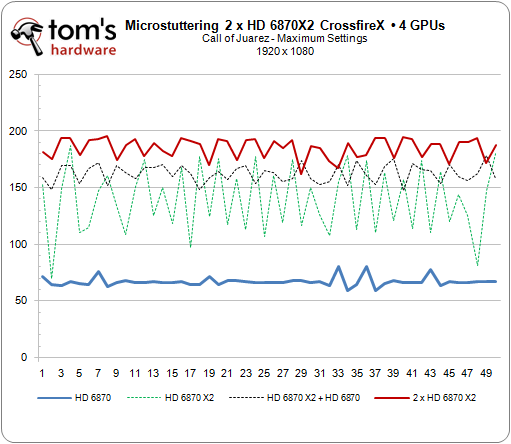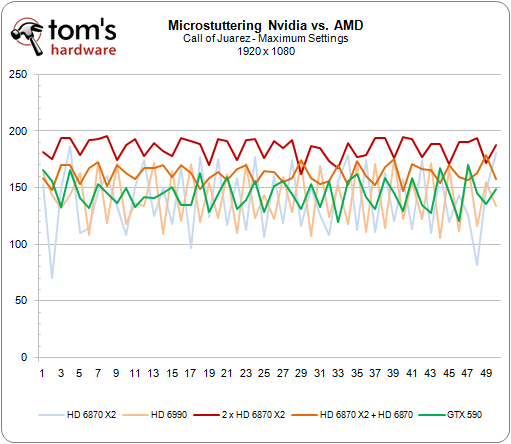Micro-Stuttering And GPU Scaling In CrossFire And SLI
We've received many emails from readers asking about the phenomenon known as micro-stuttering and what it means to multi-GPU setups in CrossFire and SLI. After running plenty of benchmarks, we're ready to weigh in on what turns out to be a real issue.
Step 3: CrossFire With Four GPUs (Vs. SLI)
Two Radeon HD 6870 X2s Give Us Four-Way CrossFire
Now we're pulling out all of the stop and harnessing four mid-range GPUs together for moderate excess. Paying PowerColor's premium on a dual-GPU board twice means you drop somewhere around $940 bucks for the privilege of rocking a highly-parallelized graphics subsystem. Let’s compare the three- and four-way CrossFire setups first:

Because that X2 costs so much more, you're forced to pay dearly for a 15 to 20% improvement over the three-way arrangement. Four-way CrossFire simply doesn't make sense given the Barts GPU and resolutions of 1920x1080. We were already seeing more than 150 FPS, after all.
Ratcheting the resolution up to bring performance down would require more on-board memory. One gigabyte per card really isn't enough for a single 30" screen at 2560x1600 or a trio of 24" displays at 5760x1080. At that point, you'd need to consider Radeon HD 6950 2 GB boards, all lined up.
CrossFire Versus SLI
We benchmarked the GeForce GTX 590 and Radeon HD 6990 anyway, just to see how they'd measure up. We would have liked to measure the performance of two GeForce GTX 590s, but we weren't able to find a second card that'd run reliably in SLI mode. We'll talk about that on the next page.
Here are all the graphs for comparison:
Stay On the Cutting Edge: Get the Tom's Hardware Newsletter
Get Tom's Hardware's best news and in-depth reviews, straight to your inbox.

Interim Assessment
It's amazing how easily Nvidia's GeForce GTX 590 is vanquished by what many folks would consider a trio of value-oriented Radeon cards. Higher frame rates and minimal micro-stuttering surprised and excited us at the same time. It almost makes sense why AMD doesn't include a second CrossFire connector on these cards now; doing so would decimate any reason to spend extra on the company's highest-end (and highest-margin) cards.
We have to curb our enthusiasm a little bit, though. The drawback of AMD's setup is, almost always, inconsistent driver performance. Three-way CrossFire is very compelling in most games and benchmarks. However, driver issues reduce its performance to the level of a dual-GPU setup in a few applications. In those cases, the only remaining benefit of three-way CrossFire is better frame rate consistency in each of the tests we ran (admittedly, no small gain).
The Radeon HD 6990 is barely faster than a Radeon HD 6870 X2. All else considered, its only advantage is less micro-stuttering than the two-chip solutions. In turn, it gets destroyed by the three-way setup.
Now we can have a look at the rest of the benchmark results, bearing in mind the configurations that best minimize the micro-stuttering issue.
Current page: Step 3: CrossFire With Four GPUs (Vs. SLI)
Prev Page Step 2: CrossFire With Three GPUs Next Page Test System And Benchmark Selection-
thorkle This is a very interesting article, I have wondered about this issue myself many times in the past. I was always curious why I would see strange lag like anomalies while still achieving perfect frame rate. Bravo TomsReply -
compton Well, I'm a little surprised that three cards in Crossfire seem to eliminate visible microstuttering -- I would have guessed that triple cards would increase stuttering. But it also seems like there must be other factors at work. Unfortunately, there really isn't a good way to test for other factor -- if you even could know what to test for. In some circumstances, it seems like my monitor is causing some issues. If I play a game (lets use Fallout New Vegas for example) at a Synced 60FPS, you can look at FPS and it never deviates. It only uses 1/3 of my GPU cycles. But on one monitor, at the same resolution, it micro stutters. On another monitor, it looks perfectly fine. I thought it was some lag variance -- but then I've been told lag is always constant, that the reason lag varies in monitor testing is improper test methods. What ever the reason, it's actually really annoying. And I'm not anything approaching a competitive FPS player. Thanks for helping to track this issue down.Reply
-
iam2thecrowe so will you now change your best gpu for the money from 2 x 6850's, since they obviously suck. I already bought one 6850 thinking it would be great to crossfire later and that was the best choice according to you toms........now i will have to throw it in the bin come upgrade time and buy a better single card. Oh, and AMD/Nvidia, if you cant get dual card configs to work properly, don't offer them, your wasting our money. Please fix this microstuttering crap, im sure it would be possible with a driver tweak.Reply -
bombat1994 i think the MSI Radeon 6870 Hawk is the best graphics card on the market right now in terms of heat, power, performance and priceReply -
tmk221 in most games you can limit maximum frame rates. So maybe if you limit max FR to let say 10 to 15 above min FR then the Micro-Stuttering effect would be gone ? anyone tried this? please shareReply -
shoelessinsight What is performance like using other load-balancing methods, like the split frame rendering that SLI originally used, or ATI's Scissor mode? Are these modes still available to those that choose them?Reply
Obviously, they won't reach frame rates as high as those attained through AFR, but if the frame rate loss is small enough, those modes might still be justifiable if they eliminate micro-stuttering altogether.
I'd be curious if these alternate methods could justify the cost of an additional card through added performance without coming with the drawback of micro-stuttering. -
boletus Regarding the decreased stuttering with 3 or 4 cards: could this be a similar effect to superimposing sine waves? Two waves a half cycle apart show visible peaks and valleys, while three waves at evenly staggered cycles form a much smoother band (on a graph or a scope).Reply -
haplo602 I ma confused ... you are using 2 identical cards, so the frame rendering times as show on the metro 2033 second would be THE SAME on a single card as on a dual card configuration. the only difference is when each card starts to render right ?Reply